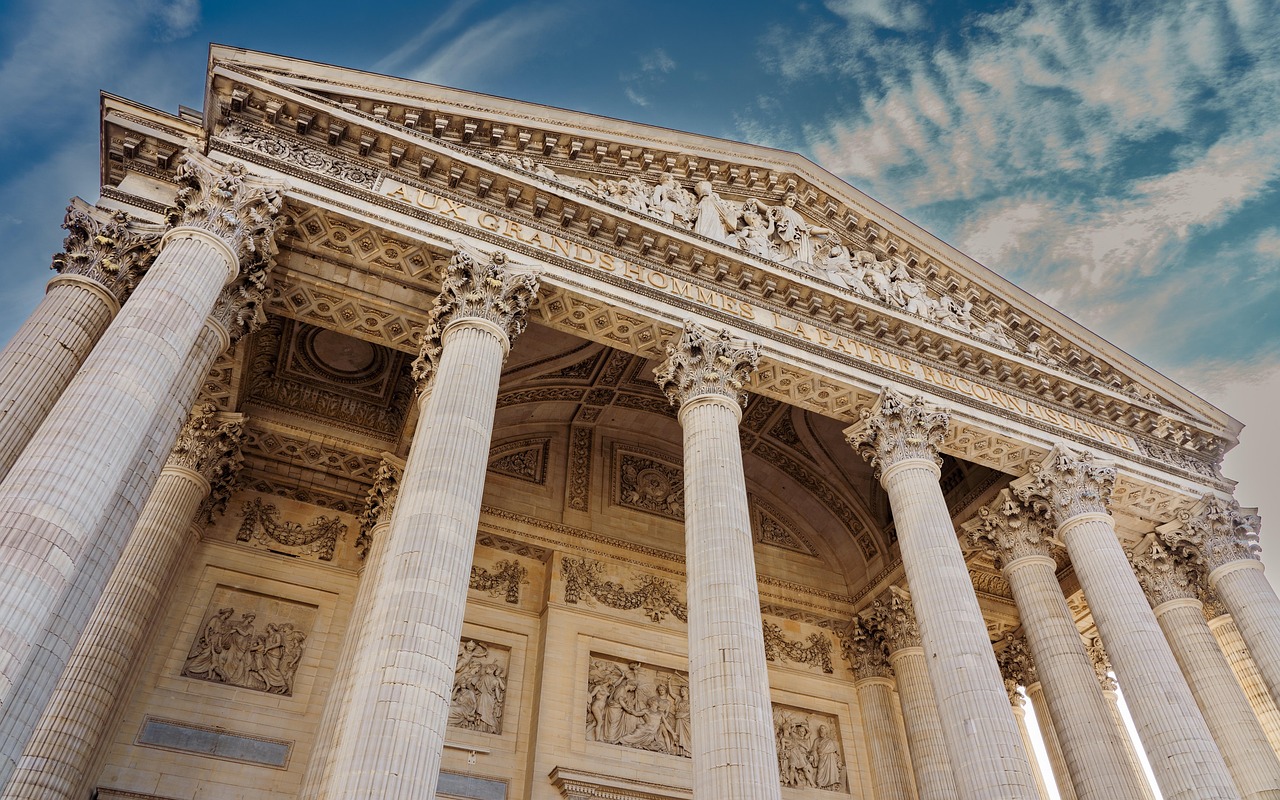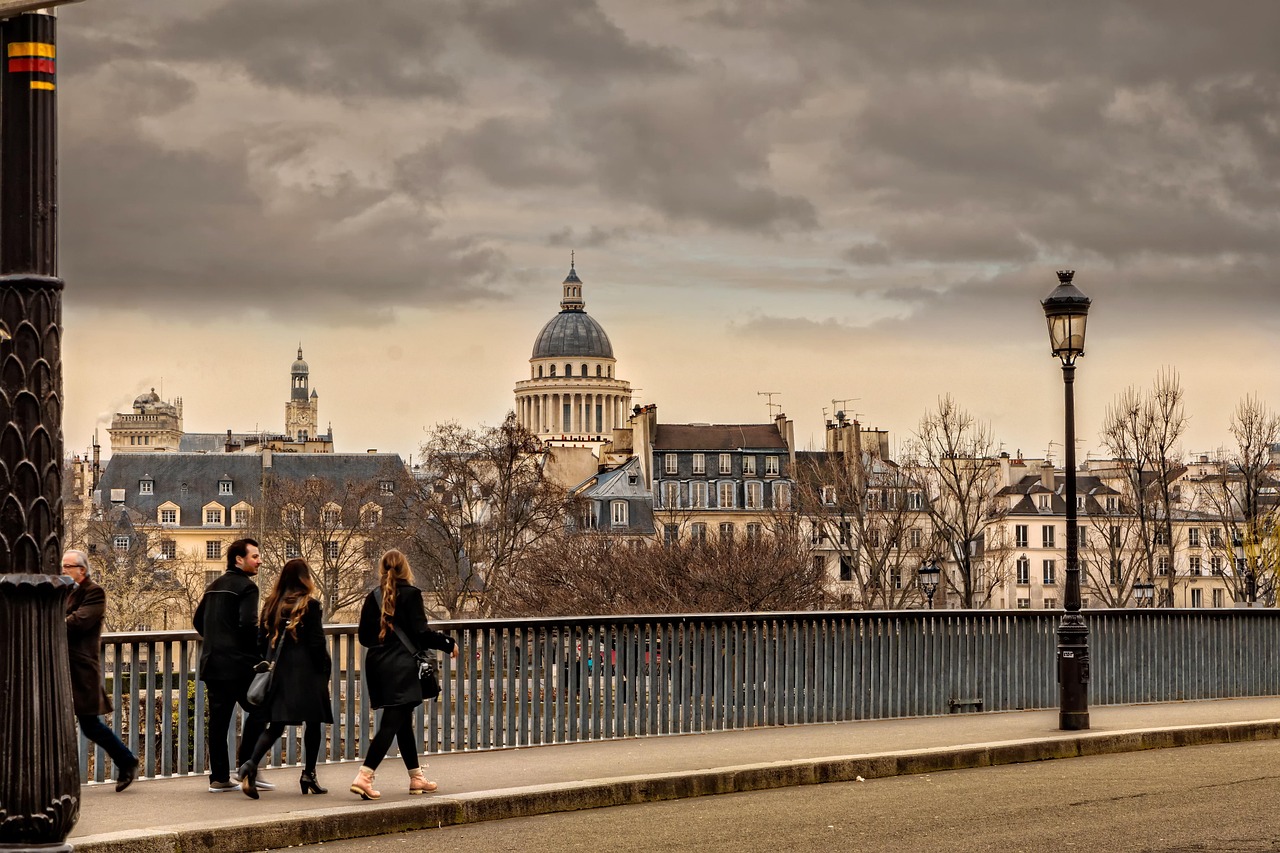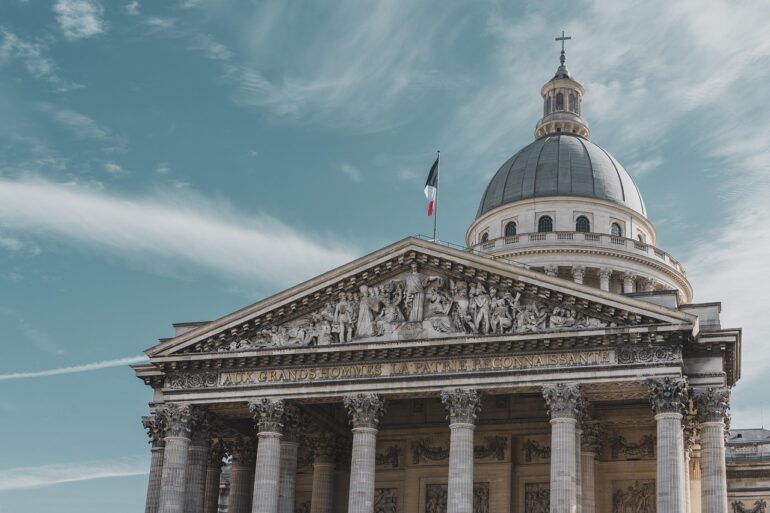What is the Panthéon?
The Panthéon in Paris is far more than just a building. It is a place of national remembrance, a tribute to the great figures of French history. Located in the Latin Quarter, this monument draws thousands of visitors each year who come to discover its history and unique architecture. But what makes the Panthéon so special?
Originally built as a church dedicated to Saint Geneviève, the patron saint of Paris, the Panthéon was transformed into a secular mausoleum at the end of the 18th century. This change in function reflected the political and social upheavals of the time, marking a break with the Ancien Régime. Today, it serves as the final resting place for men and women who have left an exceptional mark on France.
Standing proudly atop the Sainte-Geneviève hill, this monument is also a place for reflecting on national identity. It raises the question of what criteria determine whether a person deserves to be buried in this temple of collective memory. Visiting the Panthéon means discovering not just an architectural masterpiece, but also an important chapter of French history.
The History of the Panthéon: From Antiquity to Today
The history of the Panthéon begins in the mid-18th century, during the reign of Louis XV. Gravely ill, the king vowed to build a new church to thank Saint Geneviève if his health was restored. Construction began in 1758 under architect Jacques-Germain Soufflot and was completed in 1790, at the height of the French Revolution.
The Revolution marked a turning point in the building’s history. In 1791, the National Assembly decided to transform it into a “National Panthéon,” a place to house the tombs of the nation’s great men. This decision was inspired by the republican ideals of the time, which sought to honor individual merit rather than aristocratic heritage.
Over the centuries, the Panthéon underwent several changes in function, alternating between church and secular mausoleum depending on the political regime. Today, it remains a symbol of the French Republic, housing the remains of such diverse figures as Voltaire, Victor Hugo, and Marie Curie.
The Architecture of the Panthéon: A Neoclassical Masterpiece
The Panthéon is a remarkable example of neoclassical architecture. Inspired by ancient monuments, it stands out with its grand façade and impressive dome, which dominates the Parisian skyline. Architect Jacques-Germain Soufflot skillfully combined classical influences with modern construction techniques to create a structure that is both majestic and innovative.
The façade is adorned with Corinthian columns and a sculpted pediment depicting the Last Judgment, a work by David d’Angers. Inside, the vast and luminous space is supported by a series of columns under a vaulted ceiling with intersecting ribs. The Greek cross floor plan allows for smooth circulation, highlighting the artworks and tombs it contains.
The dome itself is a technical marvel. Made up of three nested shells, it reaches a height of 83 meters and offers a panoramic view of the city. This dome symbolizes spiritual and intellectual elevation, paying homage to the greatness of those who rest within.
Famous Figures Buried at the Panthéon
The Panthéon is the final resting place of many iconic figures in French history. Among the most famous are Enlightenment philosophers like Voltaire and Rousseau, whose ideas deeply influenced modern thought and the French Revolution. Their tombs continue to draw admirers, a testament to the lasting impact of their work.
Writers also hold a place of honor. Victor Hugo, author of Les Misérables and a staunch defender of human rights, was one of the first to be buried in the Panthéon following a grand ceremony in 1885. Next to him lies Émile Zola, whose novel Germinal became a landmark in social literature. These writers underscore the importance of literature in French culture.
The Panthéon also houses renowned scientists like Pierre and Marie Curie, pioneers of radioactivity. Marie Curie was the first woman to be buried there based on her own accomplishments—a powerful symbol of gender equality. These individuals represent excellence and innovation, values cherished by the French Republic.
Mysteries and Legends Surrounding the Panthéon

Like any monument steeped in history, the Panthéon is surrounded by mysteries and legends. One of the most famous involves Foucault’s Pendulum, installed inside in 1851 to demonstrate the Earth’s rotation. This scientific instrument fascinated visitors with its simplicity and ingenuity, becoming a symbol of the pursuit of knowledge.
Another legend suggests that the soul of Jean-Jacques Rousseau, buried in the Panthéon, haunts the premises. Some claim to have heard whispers or seen shadows moving in the galleries. Though unverified, such stories add a mysterious dimension to the monument, attracting lovers of the paranormal.
Even the architecture itself raises questions. The frescoes and sculptures that decorate the walls are said to contain esoteric symbols, interpreted by some as hidden messages. These elements contribute to the enigmatic aura of the Panthéon, encouraging visitors to uncover its secrets.
The Panthéon in Popular Culture
The Panthéon holds a special place in popular culture, frequently appearing in literature, film, and visual arts. This iconic Paris monument is often used as a backdrop for historical and romantic tales, reinforcing its mythical and timeless aura.
In literature, the Panthéon is mentioned in numerous novels, including Victor Hugo’s Les Misérables, where it symbolizes both the grandeur and decay of society. In cinema, it featured in films such as Midnight in Paris by Woody Allen, where it embodies the eternal charm of the City of Light.
Contemporary artists have also found inspiration in the Panthéon. Temporary exhibitions blending modern art with historical heritage are regularly held. These events offer a fresh perspective on the monument and reinforce its role as a vibrant cultural hub.
How to Visit the Panthéon: Practical Tips

Visiting the Panthéon is an unforgettable experience that requires a bit of planning. To make the most of your visit, it’s best to book tickets in advance, especially during peak tourist seasons. The site is open daily, except on certain public holidays, and guided tours are available for those who want deeper insight into the monument.
Once there, take time to admire the exterior architecture before heading inside. Don’t miss the crypt, where the nation’s great figures rest. For a breathtaking view of Paris, climb to the colonnade of the dome, accessible via a spiral staircase.
It is recommended to allow at least two hours for a full visit. As the Panthéon is located in the heart of the Latin Quarter, you can continue your discovery by wandering through the surrounding historic and cultural streets. A guidebook or mobile app can help you uncover fascinating stories and details along the way.
Events and Exhibitions at the Panthéon
The Panthéon is not only a place of remembrance but also a dynamic cultural center that regularly hosts events and exhibitions. These activities shed light on lesser-known aspects of French history and engage the public in reflecting on national heritage.
Temporary exhibitions, often organized in partnership with museums and cultural institutions, cover a wide range of topics—from art to science to social history. They provide a unique opportunity to discover rare works and archival documents.
The Panthéon is also the setting for official ceremonies, including the burials of individuals recognized for their contributions to the nation. These solemn events reinforce the Panthéon’s role as a symbol of national unity and respect for republican values.
The Panthéon’s Importance in French Society
The Panthéon holds a central place in French society, both historically and symbolically. As a temple to the nation’s great men and women, it embodies the republican values of liberty, equality, and fraternity. Each burial is a powerful act that reflects changing social attitudes and standards of recognition.
The monument is also a site of memory that helps shape national identity. By honoring illustrious figures of the past, the Panthéon recalls the struggles and progress made by France over the centuries. It encourages reflection on the journey taken and inspires hope and determination for the future.
Finally, the Panthéon is a space for intergenerational dialogue. By visiting this historically rich place, younger generations can be inspired by the courage, creativity, and commitment of those buried there. It is a living legacy that continues to nourish collective awareness and promote excellence.
Conclusion: The Panthéon’s Enduring Legacy
The Panthéon is much more than a monument. It stands as a witness to France’s major historical milestones, a symbol of the Republic, and a place of contemplation. Through its majestic architecture and the illustrious individuals it houses, it embodies the spirit of the Enlightenment and the republican ideals that shaped the nation.
Visiting the Panthéon offers a chance to reconnect with the past and envision the future. This unique site reminds us of the importance of collective memory and the recognition of individual contributions to society. It calls for engagement, reflection, and action to build a better world.
I invite you to discover—or rediscover—this jewel of French heritage. Whether you’re passionate about history, architecture, or simply curious, the Panthéon is sure to amaze and inspire you. Plan your visit today and let yourself be swept away by the magic of this extraordinary place.





